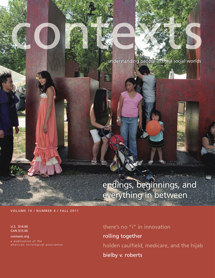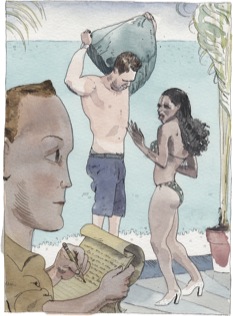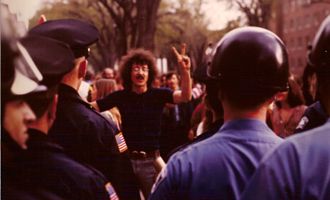So, I’m sure by now you’ve heard about the controversy that has emerged over Newt Gingrich’s repeated use of the line that Barack Obama is the “greatest food stamp President.” If not, the main question is whether the phrase is racially motivated—that is, if it is a racial code designed to play upon white fears and resentments about African Americans in general and the President in particular. (Clearly, some of the invective hurled against the President has to do with his social difference—not just his race, but the fact that he is believed (incorrectly of course) to be an immigrant, a Muslim, and an egghead, as Theda Skocpol and Vanessa Williamson report in their new book The Tea Party and the Remaking of Republican Conservativism.) You can read more about the current kerfuffle is a Sociological Images post by guest blogger Jason Eastman called “Newt Racism.”
Still, as this is something you’re likely to hear more about in the wake of Gringrich’s victory in the South Carolina primaries this weekend and it’s something that I do research on, it seems like a good time for me to bring a little social scientific research and perspective to bear.
First, some basic facts about food stamps and welfare from this weekend’s Chicago Tribune. One: more whites than blacks receive food stamps (34 percent white, 22 percent black, and 16 percent Hispanic, according to the Agriculture Department). Two: the racial breakdown for public assistance more generally is about 1/3 African American, 1/3 white, and 1/3 Hispanic. Three: funding for foodstamps actually started to rise under George W. Bush’s presidency, though it has increased under the current administration. And four: the percent of Americans receiving public assistance has declined dramatically since the welfare reform act of 1996 which imposed strict work requirements and a 5 year lifetime cap on benefits.
What the Tribune story didn’t say that is crucial is all of this is that welfare has long been and continues to be associated with race and with African Americans in particular. See Martin Gilens’s book Why Americans Hate Welfare. This perception is actually a key piece of information in itself—perhaps the key fact about welfare. It is, in short, racially coded. So even if Gingrich doesn’t intend it, this is how such references are likely to be understood by the majority of Americans. It may not be the only reason Gingrich continues to reference and discuss food stamps, but it is obviously part of the conversation.
The real question, of course, is not intent but effect. Do such racially coded messages matter? Do they impact politics, policies, and campaigns? According to Tali Mendelberg’s The Race Card, one of the most meticulously researched studies of the phenomenon, they do. Racially coded words and phrases play upon white fears about and resentment against African Americans in order to implicitly or explicity shift public opinion on and support for various candidates, campaigns, regimes, and policy initiatives.
Mendelberg, whose initial research was occasioned by the Willie Horton ad that appeared during the 1988 Presidential campaign, based her work on a wide variety of techniques and data including simulated television news experiments, national surveys, content analyses of campaign coverage, and archival cases. Key to Mendelberg’s explanation for the phenomenon is that, in a post-civil rights era there are strong norms (of equality, fairness, individualism) that prevent overt radicalized and racist images to be referenced and mobilized; however, anti-black stereotypes and perceptions remain in place—and can be mobilized in subtle, coded ways to powerful political effect. It reminds me of the old line by Malcolm X. “Racism,” he used to say, “is like a Cadillac: they make a new one every year.” In a country that is supposedly colorblind and race neutral, driven by individual opportunity and meritocracy, it can be almost no other way.
Mendelberg’s message has one ray of hope for those interested in combating radicalized political messages coded or otherwise, though: implicitly racial messages tend to lose their appeal when their content is exposed. We shall see if this is the case in the days to come as the charges and defenses are waged.
Finally, there is another point I want to highlight: race cards don’t always work and it is not just Republicans who play them. Democrats do too, though often to different effect and for different purposes. Indeed, my own work on midnight basketball and the 1994 crime bill debates with Darren Wheelock revealed that “the race card” as it pertained to midnight basketball was not played first or even most self-consciously by Republicans. Rather, that would be left to the Democrats under the leadership of Bill Clinton during the 1994 crime bill debates. And that wasn’t exactly a winner—indeed, Republicans kind of turned that against the Democrats, and it wasn’t long before Gingrich himself unveiled the “Contract” that made him famous.



 The Society Pages’ wondrous Monte Bute (that’s him, above, flashing the peace sign to the police) was picked by one MPR reporter as his favorite story/interview of the year, and so the reporter has published a quick update from the land-of-Bute:
The Society Pages’ wondrous Monte Bute (that’s him, above, flashing the peace sign to the police) was picked by one MPR reporter as his favorite story/interview of the year, and so the reporter has published a quick update from the land-of-Bute: 



